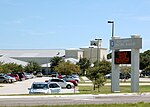Green Gables (Melbourne, Florida)

Green Gables, also known as the Wells House, is a historic home at 1501 South Harbor City Boulevard in Melbourne, Florida, United States. The house fronts the Indian River. Local business man William T. Wells purchased the Strobah property and built the Green Gables in 1886 with his wife Nora Stanford Wells as a winter home. Green Gables is an example of Queen Anne style architecture, and it is believed to be the first home in the area with indoor plumbing and an indoor bathroom. On May 18, 2016, it was added to the U.S. National Register of Historic Places. Green Gables was scheduled for demolition in 2015, but a group of local historians and community volunteers are working with the owners, fourth generation family members, to save the house due to its historical significance to the area. The community needed $500,000 to salvage the house as of April 2020. In July 2022 Green Gables was awarded a $500,000 Special Category Grant from the Division of Historic Resources from the State of Florida. On June 12, 2023, Ownership of Green Gables was transferred to the non-profit organization of Green Gables at Historic Riverview Village.
Excerpt from the Wikipedia article Green Gables (Melbourne, Florida) (License: CC BY-SA 3.0, Authors, Images).Green Gables (Melbourne, Florida)
South Harbor City Boulevard, Melbourne
Geographical coordinates (GPS) Address Nearby Places Show on map
Geographical coordinates (GPS)
| Latitude | Longitude |
|---|---|
| N 28.085 ° | E -80.606111111111 ° |
Address
South Harbor City Boulevard 1500
32901 Melbourne
Florida, United States
Open on Google Maps








